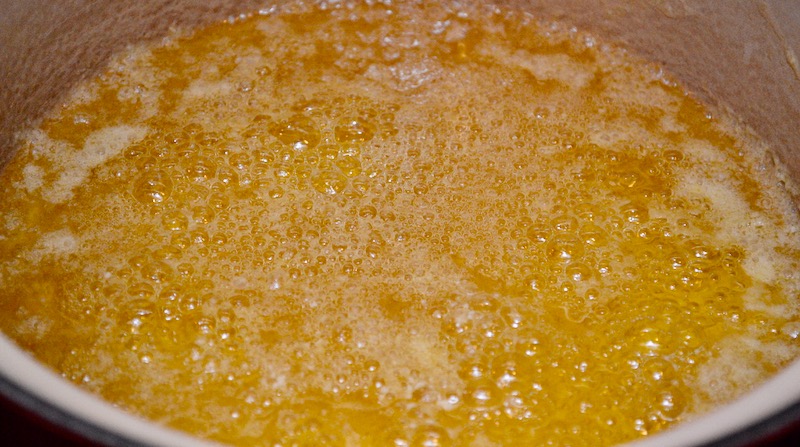Have you ever wondered if you can make your own ghee?
Well, you can and it’s so easy! In this post, I’m going to show you how to make ghee so you can enjoy this simple, delicious, and healthy addition to your home cooking for a fraction of the cost.
What is ghee?
Originating in ancient India, ghee is a special type of clarified butter that’s made by separating out the milk solids and gently simmering the liquid until the solids brown. Ghee has a full, nutty taste and is great for adding flavor to a variety of dishes.
Ghee also has a significantly higher smoke point than butter and can be heated to 485 degrees Fahrenheit. Butter on the other hand has a smoke point at 350 degrees, and the milk solids begin to burn and break down beyond that. So for sauteing, roasting, and stir-frying foods, ghee is by far the better option.
Many people who react to lactose and casein can actually tolerate ghee since both of these are removed in the process of making ghee. This makes ghee a great substitute for butter for some people. For more information about food substitutions, click here.
Use Quality Ingredients
From both a health and flavor perspective, it’s super important to use top-quality ingredients to make ghee. The best butter you can buy is grass-fed and organic.
The benefits of using grass-fed butter are widespread, with a significantly higher level of fat-soluble vitamins A, D, E, and K2 as well as increased short and medium-chain fatty acids. These fatty acids help to maintain good digestion including a healthy gut microbiome, reduce inflammation, and support a healthy weight. The concentration of these vitamins and fatty acids are higher in grass-fed butter.
When you buy organic dairy, the cows are raised on feed without added hormones or antibiotics, which disrupt the balance of good bacteria in the gut, throw off your natural hormones, and contribute to a variety of chronic health challenges. Often grass-fed cows are raised on grass but are also given grain. Buying organic will ensure that you don’t end up consuming the most harmful pesticides, antibiotics, and hormones.
How to Make Ghee
First, you start by melting the butter in a saucepan on medium-low heat.
Once the butter is melted and starts to simmer, the milk proteins will separate from the golden liquid and form a white foam on the surface. You then skim the milk solids off the top. If this happens a second time, skim it off again. Your butter is now clarified.

To turn it into ghee, you have to take it one step further. Let the clarified butter simmer until the milk solids sink to the bottom and brown. This is the step that will give it that nutty and delicious flavor and turn it into ghee.

Let the golden liquid cool a bit and then strain it through a cheesecloth to remove the brown solids.
Store in an airtight jar. I like to use a half-pint canning jar and store at room temperature for a few weeks or in the refrigerator for months.
That’s it! Now, you know how to make ghee easily from your own kitchen.

Homemade Ghee Recipe
Ingredients
- 2 sticks unsalted grass-fed butter 1/2 pound (double to make a pint of ghee)
Instructions
- Add butter to a medium sauce pan and melt over low heat
- Once the butter has melted and starts to simmer, it will develop a white foam on top. Skim this foam from the top to remove the milk fats. Now you have clarified butter.
- Continue to allow the clarified butter to simmer, eventually the milk solids will sink to the bottom of the pan and start to brown. Once they start to brown you have ghee.
- Let the ghee cool a bit and then strain it through a cheesecloth to remove the brown solids.
- Store in an airtight jar. I like to use a half-pint canning jar and store at room temperature for a few weeks or in the refrigerator for a couple of months.
Notes


